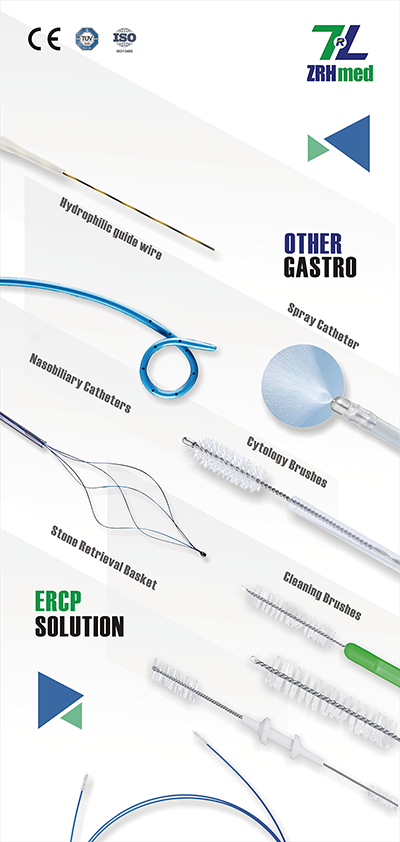Bile duct stones are divided into ordinary stones and difficult stones. Today we will mainly learn how to remove bile duct stones that are difficult to perform ERCP.
The "difficulty" of difficult stones is mainly due to the complex shape, abnormal location, difficulty and risk of removal. Compared with ERCP for bile duct tumors, the risk is equivalent or even higher. When encountering difficulties in daily ERCP work, we need to equip our minds with knowledge and let our mentality transform our skills to cope with the challenges.

01Etiological classification of "difficult stones"
Difficult stones can be divided into stone groups, anatomical abnormality groups, special disease groups and others based on their causes.
① Stone group
The main ones include huge bile duct stones, excessive stones (slam stones), intrahepatic stones, and impacted stones (complicated by AOSC). These are all situations where it is difficult to remove the stones and require early warning.
·The stone is particularly large (diameter >1.5 cm). The first difficulty in removing the stone is that the stone cannot be removed or broken by the accessories. The second difficulty is that the stone cannot be removed or broken after being removed. Emergency gravel is needed at this time.
· Exceptionally small stones should not be taken lightly. Particularly small stones can easily shift or run into the liver, and small stones are difficult to find and cover, making them difficult to treat with endoscopic treatment.
·For common bile duct-filled stones, ERCP stone removal takes too long and is easy to become incarcerated. Surgery is generally required to remove the stones.
②Anatomical abnormalities
Anatomical abnormalities include bile duct distortion, Mirrizi syndrome, and structural abnormalities in the lower segment and outlet of the bile duct. Peripapillary diverticula are also a common anatomic abnormality.
·After LC surgery, the structure of the bile duct is abnormal and the bile duct is twisted. During ERCP operation, the guide wire is "easy to put down but not easy to put on" (it falls out accidentally after finally going up), so once the guide wire is put up, it must be retained to prevent the guide wire prolapse and fall outside the bile duct.
·Mirizz syndrome is an anatomical abnormality that is easily missed and ignored. Case study: After LC surgery, a patient with cystic duct stones compressed the common bile duct, causing Mirrizz syndrome. The stones could not be removed under X-ray observation. In the end, the problem was solved after diagnosis and removal under direct vision with eyeMAX.
·For ERCP bile duct stone removal in gastric patients after Bi II surgery, the key is to reach the nipple through the scope. Sometimes it takes a long time (which requires a strong mentality) to reach the nipple, and if the guidewire is not maintained well, it can easily come out.
③Other situations
Peripapillary diverticulum combined with bile duct stones is relatively common. The difficulty in the operation at this time is the risk of nipple incision and expansion. This risk is greatest for nipples within the diverticulum, and the risk for nipples near the diverticulum is smaller.
At this time, it is also necessary to grasp the degree of expansion. The general principle of expansion is to minimize the damage required to remove stones. Smaller damage means smaller risks. Nowadays, balloon expansion (CRE) of the nipple around diverticula is generally used to avoid EST.
Patients with hematological diseases, cardiopulmonary function who cannot tolerate ERCP, or spinal joint diseases who cannot tolerate long-term left prone positioning should be paid attention to and evaluated when encountering difficult stones.m
02The psychology of facing "difficult stones"
Wrong mentality when facing "difficult stones": greed and success, recklessness, pre-operative contempt, etc.
·Greed and love for great achievements
When facing bile duct stones, especially those with multiple stones, we always want to get rid of all the stones. This is a kind of "greed" and a great success.
In fact, it is correct to take the whole and the pure, but taking the pure at all costs is too "ideal", which is unsafe and will bring a lot of difficulties and difficulties. Multiple bile duct stones should be comprehensively decided based on the patient's situation. In special cases, the tube should only be placed or removed in batches.
When huge bile duct stones are difficult to remove temporarily, "stent dissolution" can be considered. Don’t force the removal of large stones, and don’t put yourself in a very dangerous situation.
·reckless
That is, blind operation without comprehensive analysis and research often leads to stone removal failure. Therefore, cases of bile duct stones should be fully examined before surgery, objectively evaluated (requiring the ability of ERCP doctors to read pictures), careful decision-making and emergency plans should be made to prevent unexpected stone removal.
The ERCP stone extraction plan must be scientific, objective, comprehensive, and able to withstand analysis and consideration. We must adhere to the principle of maximizing patient benefit and not be arbitrary.
·contempt
Small stones in the lower part of the bile duct are easy to ignore. If small stones encounter structural problems in the lower part of the bile duct and its outlet, it will be very difficult to remove the stone.
ERCP treatment for bile duct stones has many variables and high risks. It is as difficult and risky as or even higher than ERCP treatment for bile duct tumors. Therefore, if you do not take it lightly, you will leave yourself an appropriate escape route.
03How to deal with "difficult stones"
When encountering difficult stones, a comprehensive assessment of the patient should be carried out, sufficient expansion should be done, a stone retriveal basket should be selected and a lithotripter prepared, and a prefabricated plan and treatment plan should be designed.
As an alternative, the pros and cons should be evaluated based on the patient's condition before proceeding.
·Opening processing
The size of the opening is based on the condition of the target stone and bile duct. Generally, small incision + large (medium) dilation is used to expand the opening. During EST, it is necessary to avoid large outside and small inside.
When you are inexperienced, it is easy to make an incision that is "big on the outside but small on the inside", that is, the nipple looks big on the outside, but there is no incision on the inside. This will cause the stone removal to fail.
When performing EST incision, "shallow bow and slow incision" should be used to prevent zipper incision. The incision should be as fast as each incision. The knife should not "stay still" during incision to prevent nipple interference and cause pancreatitis. .
·Processing evaluation of lower section and export
Common bile duct stones require evaluation of the lower segment and outlet of the common bile duct. Both sites must be evaluated. The combination of both determines the risk and difficulty of the nipple incision process.
·Emergency lithotripsy
Overly large and hard stones and stones that cannot be degloved need to be treated with an emergency lithotripter (emergency lithotripter).
Bile pigment stones can basically be broken into pieces, and most of the harder cholesterol stones can also be solved in this way. If the device cannot be released after retrieval, and the lithotripter cannot break stones, it is a real “difficulty”. At this time, eyeMAX may be needed to directly diagnose and treat stones.
Note: Do not use lithotripsy in the lower section and exit of the common bile duct. Do not use the lithotripsy full during lithotripsy, but leave room for it. Emergency lithotripsy is risky. During emergency lithotripsy, the end axis may be inconsistent with the bile duct axis, and the tension may be too great to cause perforation.
·Stent dissolving stone
If the stone is too large and difficult to remove, you can consider stent dissolution - that is, placing a plastic stent. Wait until the stone shrinks before removing the stone, then the chance of success will be very high.
·Intrahepatic stones
Young doctors with little experience are best not to perform endoscopic treatment of intrahepatic bile duct stones. Because the stones in this area may not be able to be trapped or may run deeper and prevent further operation, the road is very dangerous and narrow.
·Bile duct stones combined with peripapillary diverticulum
It is necessary to evaluate the risk and expectation of expansion. The risk of EST perforation is relatively high, so currently the method of balloon expansion is basically chosen. The expansion size should be just enough to remove the stone. The expansion process should be slow and step by step, and no violent expansion or expansion is allowed. Syringe expands at will. If there is bleeding after dilation, appropriate treatment is required.
We, Jiangxi Zhuoruihua Medical Instrument Co.,Ltd., is a manufacturer in China specializing in the endoscopic consumables, such as biopsy forceps, hemoclip, polyp snare, sclerotherapy needle, spray catheter, cytology brushes, guidewire, stone retrieval basket, nasal biliary drainage catheter etc. which are widely used in EMR, ESD, ERCP. Our products are CE certified, and our plants are ISO certified. Our goods have been exported to Europe, North America, Middle East and part of Asia, and widely obtains the customer of the recognition and praise!
Post time: Jul-26-2024


